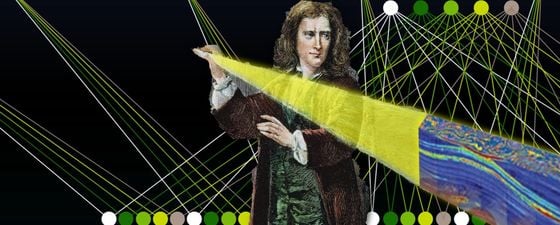Guest Contributors: Johan O. A. Robertsson and Dirk-Jan Van Manen (ETH Zurich, Institute of Geophysics). Editors: Lasse Amundsen and Martin Landrø.
Truth is ever to be found in simplicity, and not in the multiplicity and confusion of things. Sir Isaac Newton
Marine seismic data acquisition is changing rapidly. One of these developments is the use of so-called ‘simultaneous sources’, where multiple seismic sources that intentionally interfere with one another are activated simultaneously. Proposed and demonstrated over 15 years ago, the subject of marine simultaneous sources saw long fallow periods when nothing seemed to happen until the uptake of wide-azimuth surveys and, more recently, when the industry needed to improve the way in which geophysicists deliver high quality data while maintaining viability in a cost-focused market. The goal is to challenge conventional thinking and explore what could be the solutions of the future.
Traditionally, seismic data have been acquired sequentially: an impulsive source is fired and data are recorded until the energy that comes back has diminished and all reflections of interest have been captured, after which a new shot at a different location is fired. Being able to acquire data from several sources at the same time is clearly highly desirable, as the example acquisition configuration in Figure 1 suggests. Not only would it allow us to cut expensive acquisition time drastically, but it would better sample the wavefield on the source side, which typically is much more sparsely sampled than the distribution of receiver positions. It would also allow for better illumination of the target from a wide range of azimuths and would acquire more data from the wavefield in areas with surface obstructions. In addition, for some applications such as 3D VSP acquisition, or marine seismic surveying in environmentally sensitive areas, reducing the duration of the survey is critical in order to save costs external to the seismic acquisition itself (e.g., down-time of a producing well) or to minimise the impact on marine life (e.g., avoiding mating or spawning seasons of fish species).
Figure 1
Example of using multiple sources on one vessel to increase cross-line sampling density.
a) In conventional sequential shooting, one source (green) is fired at a first location yielding the subsurface points dotted green and the second source (yellow) is fired at a second location, typically 25m away, giving the subsurface points dotted yellow. In simultaneous shooting, both sources are fired together, thus improving the cross-line trace density.
b) By extending the concept to a five source configuration a significant increase in data density is achieved. The challenge for the geophysicist is to intelligently ‘encode’ the sources so that the overlapping data measurements can be ‘decoded’ into data that would be acquired from each individual source.
Simultaneous Source Seismic Data Acquisition
Simultaneous sources have a long history in land seismic acquisition, dating back at least to the early 1980s. Commonly used on land are vibroseis sources, which offer the possibility of illuminating the subsurface with source signal sweeps designed to ‘share’ the use of certain frequency bands, avoiding simultaneous interference at a given time from different sources. By carefully choosing source sweep functions, activation times and locations of different vibroseis sources, it is possible to mitigate interference between sources. Such approaches are often referred to as slip-sweep acquisition techniques. Moreover, it is also possible to design sweeps that are mutually orthogonal to each other such that the response from different sources can be isolated after acquisition through simple cross-correlation procedures with sweep signals from individual sources.
The use of simultaneous source acquisition in marine seismic applications is more recent, as marine seismic sources (i.e. airguns) do not appear to yield the same benefits in providing orthogonal properties as land seismic vibroseis sources do, at least not at first glance.
Western Geophysical was among the early proponents of marine simultaneous source seismic acquisition, and suggested that separation was carried out as a pre-processing step by assuming that the reflections caused by the interfering sources have different characteristics. Beasley et al. (1998) exploited the fact that, provided that the subsurface structure is approximately layered, a simple simultaneous source separation scheme can be achieved, for instance, by having one source vessel behind the spread acquiring data simultaneously with the source towed by the streamer vessel in front of the spread. Simultaneous source data recorded in such a fashion is straightforward to separate after a frequency-wave number (fk) transform, as the source in front of the spread generates data with only positive wave numbers, whereas the source behind only generates negative wave numbers.
The Stochastic Approach
Figure 2: Four-vessel approach to wide-azimuth seismic utilises two recording vessels towing streamers with sources plus two source-only vessels. The distance between each vessel is typically 1,200m (Moldovenau et al., 2008). (Source: WesternGeco)
Another method for enabling or enhancing separability is to make the delay times between interfering sources incoherent (Lynn et al., 1987). Since the shot time is known for each source, they can be lined up coherently for a specific source in, for instance, a common receiver gather or a common offset gather, where all arrivals from all other simultaneously firing sources will appear incoherent. To a first approximation it may be sufficient to just process the data for such a shot gather to a final image, relying on the processing chain to attenuate the random interference from the simultaneous sources. However, it is, of course, possible to achieve better results, for instance through using random noise attenuation to separate the coherent signal from the apparently incoherent signal (Stefani et al., 2007).
In recent years, with elaborate acquisition schemes to, for example, acquire wide azimuth data with multiple source and receiver vessels (Figure 2), simultaneous source acquisition has become a hot topic of research and several authors have described methods that separate ‘random dithered sources’ through sophisticated inversion approaches which exploit the sparse nature of seismic data in the time-domain (i.e., seismic traces can be thought of as a subset of discrete reflections with ‘quiet periods’ in between). Figures 3 and 4 illustrate the results using such an approach by co-workers at Chevron and presented in a paper by Akerberg et al. (2008).
Figure 3: Simultaneous source acquisition separation result from a dataset from the Gulf of Mexico. A CMP gather of input, primary estimate, secondary estimate and residual. (Reproduced from Akerberg et al., 2008. Chevron is thanked for the permission to show the dataset.)
A different approach to simultaneous source separation has been to modify the source signature emitted by airgun sources, which comprise several (typically three) sub-arrays along which multiple clusters of smaller airguns are located. As, in contrast to land vibroseis sources, it is not possible to design arbitrary source signatures for marine airgun sources, in principle one has the ability to choose firing time (and amplitude i.e., volume) of individual airgun elements within the array, meaning it is possible to choose source signatures that are dispersed as opposed to focused in a single peak. Such approaches have been proposed to reduce the environmental impact in the past (Ziolkowski, 1987) but also for simultaneous source shooting. Abma et al. (2015) suggested using a library of ‘popcorn’ source sequences to encode multiple airgun sources such that the responses can be separated after simultaneous source acquisition by correlation with the corresponding source signatures, following a practice that is similar to land simultaneous source acquisition. The principle is based on the fact that the cross-correlation between two (infinite) random sequences is zero whereas the autocorrelation is a spike. It is also possible to choose binary encoding sequences with better or optimal orthogonality properties such as Kasami sequences (discussed in Codes and Ciphers – PART I: Decoding Nature’s Disorder) to encode marine airgun arrays (Robertsson et al., 2012). Mueller et al. (2015) propose to use a combination of random dithers from shot to shot with deterministically encoded source sequences at each shot point.
Figure 4: Simultaneous source acquisition separation result from a dataset from the Gulf of Mexico. a) A stack section without secondary suppression. b) Same section as in a), but with secondary suppression and subsequent diversity noise attenuation. (Reproduced from Akerberg et al., 2008. Chevron is thanked for the permission to show the dataset.)
Figure 4: Simultaneous source acquisition separation result from a dataset from the Gulf of Mexico. a) A stack section without secondary suppression. b) Same section as in a), but with secondary suppression and subsequent diversity noise attenuation. (Reproduced from Akerberg et al., 2008. Chevron is thanked for the permission to show the dataset.)
Recently, there has been industry interest in exploring the feasibility of marine vibroseis sources, as they would, among other things, appear to provide more degrees of freedom to optimise mutually orthogonal source functions beyond just binary orthogonal sequences, which would allow for a step change in simultaneous source separation of marine seismic data. However, we believe the engineering challenges of a marine vibroseis source are immense and the robustness and ability to provide the broad spectrum of the marine airgun array are very hard to match using other source technologies.
Newton’s Ghostly Apparition
The word ‘spectrum’, from the Latin word ‘spectre’ which means ‘ghostly apparition’, was introduced by Newton (1672) in relation to his studies of the decomposition of white light into a band of light colours, when passed through a glass prism.
Prior to Newton’s work, people believed that colour was a mixture of light and darkness, and that prisms coloured light. To show that they did not, Newton refracted the light back into single white light.
‘Seismic apparition’ is a buzz phrase, introduced by two of the authors in relation to simultaneous source separation (see below for more detail).
Engraving (opposite): Issac Newton experimenting with a glass prism and white light, after a picture by John Adam Houston (1811–1884), ca. 1870.
The Deterministic Approach: Seismic Apparition
A recent development, referred to as ‘seismic apparition’, suggests an alternative approach to deterministic simultaneous source acquisition. Robertsson et al. (2016) show that by using simple modulation functions from shot to shot (e.g., a simple short time delay or an amplitude variation), the recorded data on a common receiver gather or a common offset gather will be deterministically mapped onto known parts of, for example, the fk-space outside the conventional ‘signal cone’ where conventional data is strictly located (Figure 5a). The signal cone contains all propagating seismic energy with apparent velocities between water velocity (straight lines with apparent slowness of +-1/1,500 s/m in fk-space ) and infinite velocity (i.e., vertically arriving events plotting on a vertical line with wave number 0). The shot modulation generates multiple new signal cones that are offset along the wave number axis thereby populating the fk-space much better and enabling exact simultaneous source separation below a certain frequency (Figure 5b). Robertsson et al. (2016) referred to the process as ‘wavefield apparition’ or ‘signal apparition’ in the meaning of ‘the act of becoming visible’. In the spectral domain, the wavefield caused by the periodic source sequence is nearly ‘ghostly apparent’ and isolated.
Figure 5
a) In geosciences, we plot time-offset data (not shown) in frequency-wave number (fk) diagrams to examine the direction and apparent velocity 2πf/k of seismic waves. Here fm is the maximum frequency; ks the spatial sampling frequency; and kn = ks/2 is the spatial Nyquist frequency. Typically, seismic data plots into the fk signal cone bounded by the dashed white line, determined by the water speed. Observe that there is plenty of ‘space’ in fk that has no signal. This is utilised in seismic apparition by designing periodic source sequences that place seismic energy into this empty space.
b) For two sources shot simultaneously, the seismic apparition technique samples two source wavefields, sampled at spatial frequencies ks and ks/2 respectively. The cone centred around k=0 contains information about both source wavefields (overlapping signals). The cones centred around kn, however, only contain information from the source that has been fired in a periodic way. By intelligent data processing, the data from the two sources can be decoded.
The word ‘spectrum’ was introduced by Newton (1672) in relation to his studies of the decomposition of white light into a band of light colours, when passed through a glass prism. This word seems to be a variant of the Latin word ‘spectre’, which means ‘ghostly apparition’. A critical observation and insight in the ‘seismic apparition’ approach is that partially shifting energy along the k-axis is sufficient as long as the source variations are known, as the shifted energy fully predicts the energy that was left behind in the ‘conventional’ signal cone. Following this methodology, simultaneously emitting sources can be exactly separated using a simple modulation scheme where, for instance, amplitudes and/or firing times are varied deterministically from shot to shot in a periodic pattern.
Call for Revolution?
It has been suggested that simultaneous source separation is an unnecessary step as all that matters is the spatial and temporal spectrum of the energy that illuminates the subsurface. It has been argued that as long as the conventional approach of regarding seismic data as a sequence of single shot records is abandoned, it would be possible to create images of the subsurface from the total energy that illuminates it, whether from surface-related multiples or simultaneously emitting sources. Although such a philosophy appears appealing it would call for a revolution in the way that seismic data are processed and imaged, quite different from the conventional approach of imaging based on the separation of the velocity model-building step from the imaging step, introduced by Jon Claerbout in the 1960s.
Other Applications
Finally, simultaneous source acquisition has other applications of interest to seismic imaging. In particular, in modelling and inversion the computational cost can be reduced proportionally if it were possible to generate the response to multiple sources during a single finite difference simulation, for example. Although there are some promising developments on the horizon, the silver bullet to crack this problem has not yet appeared. The key to unlock this grand challenge may well lie somewhere amongst the approaches discussed in this pair of articles.
Also in this Series
Codes and Ciphers – PART I. Decoding Nature’s Disorder. Guest Contributors: Dirk-Jan Van Manen and Johan O. A. Robertsson (ETH Zurich, Institute of Geophysics). Editors: Lasse Amundsen and Martin Landrø.
References
R. Abma, D Howe, M Foster, I Ahmed, M Tanis, Q Zhang, A Arogunmati , and G Alexander 2015 Independent simultaneous source acquisition and processing: Geophysics 80(6) WD37 WD44.
Akerberg P, G Hampson, J Rickett, H Martin, and J Cole 2008 Simultaneous source separation by sparse Radon transform: 78th Annual International Meeting, SEG Expanded Abstracts 2801–2805.
Beasley C J, R E Chambers, and Z Jiang 1998 A new look at simultaneous sources: 68th Annual International Meeting, SEG Expanded Abstracts 133–136.
Lynn W, M Doyle, K Larner, and R Marschall 1987 Experimental investigation of interference from other seismic crews: Geophysics 52 1501–1524.
Marple Jr, S L1987 Digital Spectral Analysis with Applications: Englewood Clis, NJ, Prentice Hall.
Moldoveanu N, J Kapoor, and M Egan 2008 Full-azimuth imaging using circular geometry acquisition: The Leading Edge 27(7) 908-913.
Mueller M B, D F Halliday, D J van Manen, and J O A Robertsson 2015 The benefit of encoded source sequences for simultaneous source separation: Geophysics 80(5) V133-V143.
Newton I 1672 A letter of mr. isaac newton, professor of the mathematicks in the university of cambridge; containing his new theory about light and colors: Sent by the author to the publisher from cambridge, febr. 6. 1671/72; in order to be communicated to the r. society. Phil. Trans. 6 3075–3087.
Robertsson J O A, L Amundsen, and Å S Pedersen 2016 Simultaneous source wavefield separation by signal apparition: Geophysical Journal International 206(2) 1301-1305
Robertsson J O A, D Halliday, D J van Manen, I Vasconcelos, R Laws, K Özdemir, and H Grønaas 2012 Full-wavefield, towed-marine seismic acquisition and applications: 74th Conference and Exhibition, EAGE Extended Abstracts.
Stefani J, G Hampson, and E F Herkenhoff 2007 Acquisition using simultaneous sources: 69th Annual International Conference and Exhibition, EAGE Extended Abstracts B006.
Ziolkowski A M 1987 The determination of the far-field signature of an interacting array of marine seismic sources from near-field measurements: Results from the Delft Air Gun experiment: First Break 5 15–29





